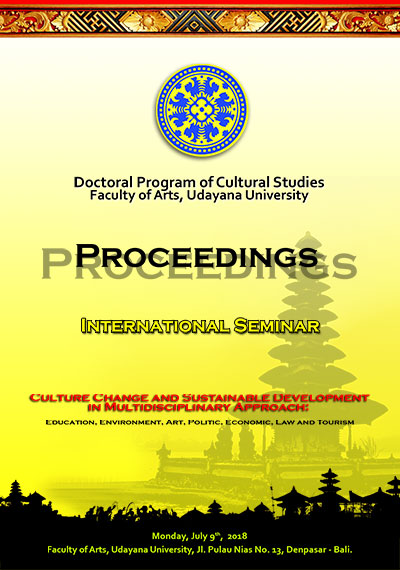CULTURAL ECOLOGY CHANGE AND SUSTAINABLE DEVELOPMENT: CHALLENGES FOR KAJIAN BUDAYA IN PRAXIS
Abstract
This essay reflects on the distinct approach of the Balinese school of Kajian Budaya at Universitas Udayana, initiated by the now-late I Gusti Ngurah Bagus, particularly in terms of the topic of cultural ecology change and sustainable development. It draws from my years of work as a dance-movement artist, teacher and cultural program director to insights gained during my doctoral studies to my application of the findings in subsequent participatory practice-based work. By doing so, I hope to stimulate us to consider the questions of what is the relevance of Kajian Budaya to our vocations in various fields? How might we make use of Kajian Budaya as praxis? Also, how can Kajian Budaya foster cultural creativity for the well-being of the earth and humanity?
Downloads
References
Butler, Diane. 2016. “Living Prayer: Its Contributions for the World’s Ecosystems and Interreligious Harmony”. Jurnal Kajian Bali, Vol. 6, No. 1, April, pp. 81–118. http://ojs.unud.ac.id/index.php/kajianbali/article/view/19900/13214 Abbreviated version published on the 2016 World Culture Forum website https://worldcultureforum-bali.org/living-prayer-contributions-for-the-worlds-ecosystemsand-interreligious-harmony/
Butler, Diane Carol. 2011. Religiosity in Art inspired by Samuan Tiga and Tejakula, Bali: Unity in Diversity. Thesis (Ph.D.), Universitas Udayana, Bali. Abstract and summary in E-Journal of Cultural Studies, Vol. 5, No. 2, Juli. http://ojs.unud.ac.id/index.php/ecs/article/view/3643/2672
Fadlillah. 2003. “Cultural Studies” Mazhab Bali: Sebuah Paradigma Baru Kajian Budaya”. Kompas, 16 Februari, hal. 18.
Heron, John and Reason, Peter. 1997. “A Participatory Inquiry Paradigm”. Qualitative Inquiry, Vol. 3, No.
3, pp. http://people.bath.ac.uk/mnspwr/Papers/Participatoryinquiryparadigm.pdf
Kartohadikoesoemo, Soetardjo. 1984. Desa. 3rd edn, Jakarta: Balai Pustaka. [Original edn, 1953]. Mohamad, Goenawan. 2017. “Universitas dan Pasca-Kebenaran”. Ceramah untuk Hari Ulang Tahun Universitas Negeri Sebelas Maret, 11 Maret.
Nasr, Sayyed Hossein.1984. Antara Tuhan, Manusia dan Alam, 2003. Ali Noer Zaman (trans.), Edi AH Iyubenu et al (eds). Yogyakarta: IRCiSoD. Indonesian edn, The Encounter Man and Nature. University of California Press.
Novack, Cynthia [under the name of Bull, Cynthia Jean Cohen]. 1997. Sense, Meaning, and Perception in Three Dance Cultures. Jane Desmond (ed.), Meaning in Motion: New Cultural Studies of Dance. Durham, Duke University Press, pp. 269–288.
Posey, Darrell Addison (ed.). 1999. Cultural and Spiritual Values of Biodiversity: A Complementary Contribution to the Global Biodiversity Assessment. London/Nairobi: Intermediate Technology Publications/UNEP. http://www.unep.org/pdf/Cultural_Spiritual_thebible.pdf
Soebadio, Haryati. 1986. “Kepribadian budaya bangsa”. In Ayatrohaedi (ed.). Kepribadian Budaya Bangsa (Local Genius), pp. 18–25. Jakarta: Pustaka Jaya.
Steward, Julian H. 1995. Theory of Culture Change: the method of multilinear evolution. Urbana: University of Illinois Press.
Universitas Udayana. 2016. Statuta Universitas Udayana Tahun 2016. Bukit Jimbaran, 26 Agustus. World Culture Forum. 2016. “Bali Declaration”, adopted by participants of the 2nd World Culture Forum: Culture for an Inclusive Sustainable Planet. Nusa Dua, 13 October. Indonesia: Ministry of Education and Culture and UNESCO. http://www.unesco.or.id/download/WCF_2016_ Declaration.pdf
Wright, Handel Kashope. 2003. “Cultural Studies as Praxis: (making) an autobiographical case”. Cultural Studies, Vol. 17, No. 6, pp. 805–822.

This work is licensed under a Creative Commons Attribution-NonCommercial-ShareAlike 4.0 International License.





